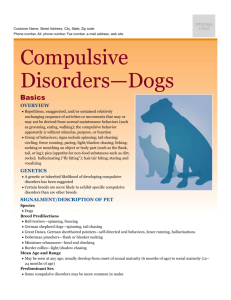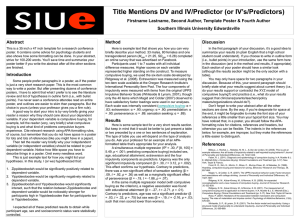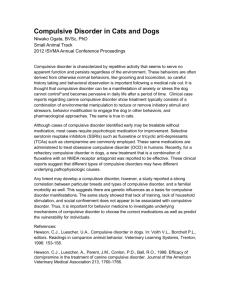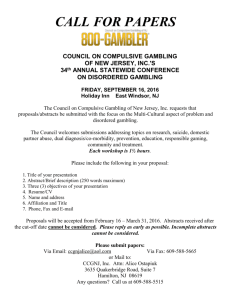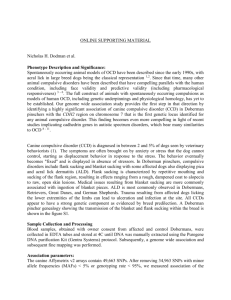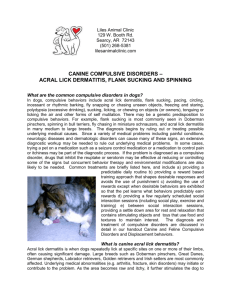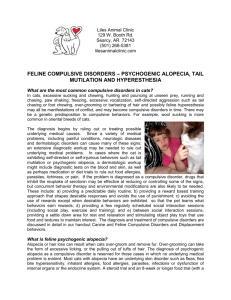COMPULSIVE CONSUMPTION Ronald J. Faber, University of Texas
advertisement
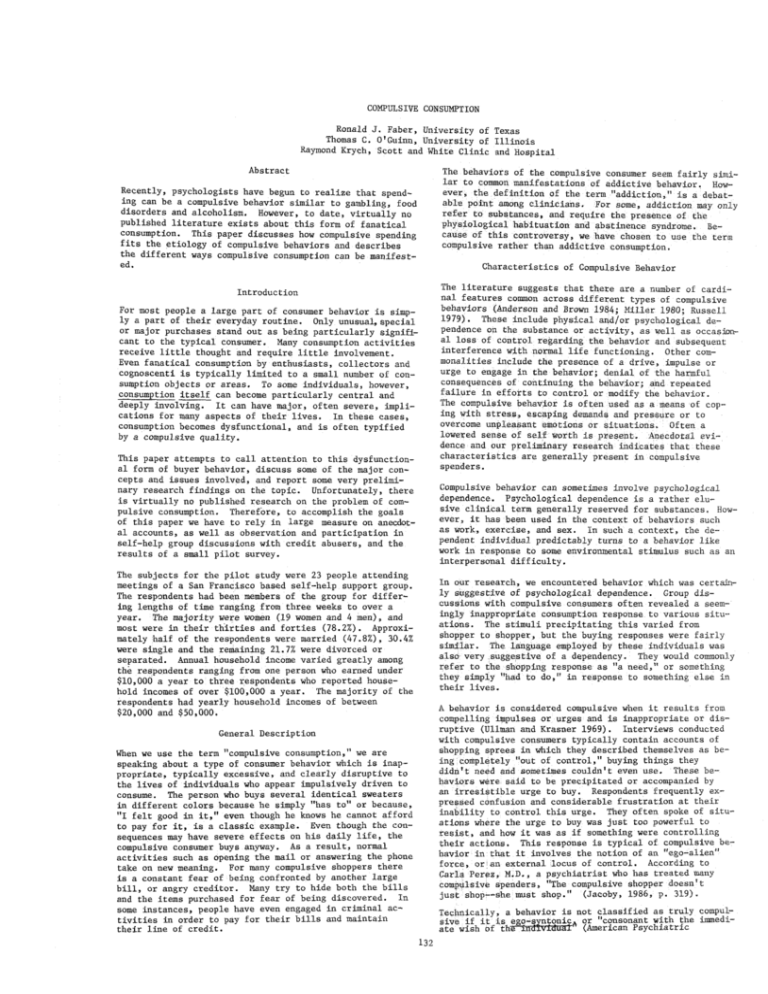
COMPULSIVE CONSUMPTION Ronald J. Faber, University of Texas Thomas C. O'Guinn, University of Illinois Raymond Krych, Scott and White Clinic and Hospital Abstract The behaviors of the compulsive consumer seem fairly similar to common manifestations of addictive behavior. However, the definition of the term "addiction," is a debatable poiht among clinicians. For some, addiction may only refer to substances, and require the presence of the physiological habituation and abstinence syndrome. Because of this controversy, we have chosen to use the term compulsive rather than addictive consumption. Recently, psychologists have begun to realize that spending can be a compulsive behavior similar to gambling, food disorders and alcoholism. However, to date, virtually no published literature exists about this form of fanatical consumption. This paper discusses how compulsive spending fits the etiology of compulsive behaviors and describes the different ways compulsive consumption can be manifested. Characteristics of Compulsive Behavior The literature suggests that there are a number of cardinal features common across different types of compulsive behaviors (Anderson and Brown 1984; Miller 1980; Russell 1979). These include physical and/or psychological dependence on the substance or acti.vlty, as well as occasional loss of control regarding the behavior and subsequent interference with normal life functioning. Other commonalities include the presence of a drive, impulse or urge to engage in the behavior; denial of the harmful consequences of continuing the behavior; and repeated failure in efforts to control or modify the behavior. The compulsive behavior is often used as a means of coping with stress, escaping demands and pressure or to overcome unpleasant emotions or situations. Often a lowered sense of self worth is present. AnecdotiSl evidence and our preliminary research indicates that these characteristics are generally present in compulsive spenders. Introduction For most people a large part of consumer behavior is simply a part of their everyday routine. Only unusual, special or major purchases stand out as being particularly significant to the typical consumer. Many consvunption activities receive little thought and require little involvement. Even fanatical consumption by enthusiasts, collectors and cognoscenti is typically limited to a small number of consumption objects or areas. To some individuals, however, consumption itself can become particularly central and deeply involving. It can have major, often severe, implications for many aspects of their lives. In these cases, consumption becomes dysfunctional, and is often typified by a compulsive quality. This paper attempts to call attention to this dysfunctional form of buyer behavior, discuss some of the major concepts and issues involved, and report some very preliminary research findings on the topic. Unfortunately, there is virtually no published research on the problem of compulsive consumption. Therefore, to accomplish the goals of this paper we have to rely in large measure on anecdotal accounts, as well as observation and participation in self-help group discussions with credit abusers, and the results of a small pilot survey. Compulsive behavior can sometimes involve psychological dependence. Psychological dependence is a rather elusive clinical term generally reserved for substances. However, it has been used in the context of behaviors such as work, exercise, and sex. In such a context, the dependent individual predictably turns to a behavior like work in response to some environmental stimulus such as an interpersonal difficulty. The subjects for the pilot study were 23 people attending meetings of a San Francisco based self-help support group. The respondents had been members of the group for differing lengths of time ranging from three weeks to over a year. The majority were women (19 women and 4 men), and most were in their thirties and forties (78.2%). Approximately half of the respondents were married (47.8%), 30.4% were single and the remaining 21.7% were divorced or separated. Annual household income varied greatly among the respondents ranging from one person who earned under $10,000 a year to three respondents who reported household incomes of over $100,000 a year. The majority of the respondents had yearly household incomes of between $20,000 and $50,000. In our research, we encountered behavior which was certainly suggestive of psychological dependence. Group discussions with compulsive consumers often revealed a seemingly inappropriate consumption response to various situations. The stimuli precipitating this varied from shopper to shopper, but the buying responses were fairly similar. The lainguage employed by these individuals was also very suggestive of a dependency. They would commonly refer to the shopping response as "a need," or something they simply "had to do," in response to something else in their lives. A behavior is considered compulsive when it results from compelling impulses or urges and is inappropriate or disruptive (Ullman and Krasner 1969). Interviews conducted with compulsive consiimers typically contain accounts of shopping sprees in which they described themselves as being completely "out of control," buying things they didn't need and sometimes couldn't even use. These behaviors w6re said to be precipitated or accompanied by an irresistible urge to buy. Respondents frequently expressed confusion and considerable frustration at their inability to control this urge. They often spoke of situations where the urge to buy was just too powerful to resist, and how it was as if something were controlling their actions. This response is typical of compulsive behavior in that it involves the notion of an "ego-alien" force, or; an external locus of control. According to Carla Perez, M.D., a psychiatrist who has treated many comptilsive spenders, "The compulsive shopper doesn't just shop-—she must shop." (Jacoby, 1986, p. 319). General Description When we use the term "compulsive consumption," we are speaking about a type of consumer behavior which is inappropriate, typically excessive, and clearly disruptive to the lives of individuals who appear impulsively driven to consume. The person who buys several identical sweaters in different colors because he simply "has to" or because, "I felt good in it," even though he knows he cannot afford to pay for it, is a classic example. Even though the consequences may have severe effects on his daily life, the compulsive consumer buys anyway. As a result, normal activities such as opening the mail or answering the phone take on new meaning. For many compulsive shoppers there is a constant fear of being confronted by another large bill, or angry creditor. Many try to hide both the bills and the items purchased for fear of being discovered. In some instances, people have even engaged in criminal activities in order to pay for their bills and maintain their line of credit. Technically, a behavior is not classified as truly compulsive if it is ego'^syntonici or "consonant with the immediate wish of the indlvidttal" (American Psychiatric 132 Association 1980, p. 291). If there is "pleasure, cation or release at the time of committing the act," the behavior would instead be termed "a disorder of impulse control" (American Psychiatric Association 1980, p. 291). The extent to which "compulsive consumption is egodystonic or ego-syntonic is still unknown. In many cases it does seem more to follow the true compulsive model and be the result of involuntary thoughts which "invade consciousness, and are experienced as senseless and repugnant" (American Psychiatric Association 1980,, p. 235). However, in some cases the act itself does appear pleasurable, at least initially. This distinction may eventually prove to be an important diagnostic and research criterion. For now, however, we will use the term "compulsive consumption" to apply to both situations. For many, if not most compulsive purchasers, buying is a reaction to stress or unpleasant situations. One section of the questionnaire that we administered to compulsive consumers asked them to complete a number of sentences. One sentence fragment read, "I am most likely to buy myself something when . . ." Among our respondents, 43..5% completed this sentence by giving a negative emotion such as "I'm depressed" or "feel bad about myself" as their first response. An additional 30.4% talked about negative feelings as some part of their response although not the first thing they mentioned. Belk (1985) used this same sentence fragment in his study of materialism across three generations in families. In his study, only 20% of the respondents completed this sentence by mentioning any type of emotional state (either negative or positive) or by mentioning impulse pulrchases. Compulsive consumers' use of shopping as an escape from unhappiness can also be seen in the responses to the following sentence completion question used both in our study and by Belk: "When I don't feel good about myself I'm likely to . . ." The major responses that Belk reports are: "act depressed" (32%); "try to feel better" (25%); and "withdraw from others" (20%). Unfortunately, he does not indicate what types of answers comprise the remaining 22% of the responses, so we don't know what percent involve buying behaviors. However, the likelihood is it is very small. In our sample, "spend money/shop" (30.4%) was tied with "sleep/withdraw" (30.4%) as the most common response. Thus, it seems that for at least some compulsive shoppers buying is a predominant way of coping with unhappiness. spouse) that they hid their purchases in the trunk of their car or in a closet and never used these things. Others reported buying so many things that they never got to use all of them. One question we asked on our survey tried to get at the degree to which this occurs. We asked the people to respond on a five-point scale going from "strongly agree" to "strongly disagree" to several statements. One statement read, "My closets are filled with still unopened items." Vfhile no comparison exists from a general population, it is considered unlikely that many people would agree with this statement. Among the compulsive consumers, however, 43.4% either strongly or somewhat agreed with it. Both the fear of being discovered and the. reality of spending beyond their means Interferes with the lives of many compulsive spenders. Almost all report some feelings of guilt and anxiety over their behavior. It is, perhaps, this reaction to buying which most clearly distinguishes compulsive consumers from other shoppers. The fear and guilt associated with buying was evident in responses to another sentence completion question we used, which began, "When I use my credit card . . ." Many respondents naturally finished this sentence with some reference to spending more than if they paid cash (27.3%), or feelings of power or importance (13.6%). These responses would probably also be cOTsmon among noncompulsive consumers. More interesting, however, was the number of people who completed this sentence by mentioning either feelings of fear/anxiety (18.2%) or guilt (18.2%). For these people, it would seem that buying is not totally an enjoyable activity. Thus, based on our preliminary research it appears that compulsive consumption matches most, if not all, of the characteristics associated with compulsive behaviors. Incidence Since compulsive consumption is just now being recognized as a problem and many compulsive spenders may be unaware that they have a problem or deny that it is a problem, a good estimate of its magnitude is unavailable. However, mounting evidence from different sources indicates that this may well be a large and growing affliction. Group interview responses also supported thiss notion. Almost all respondents at some point linked an affective or mood state to their compulsive behavior. Interestingly, however, it was not always a negative one. Some respondents experienced the presence of tbis powerful urge to spend excessively when they were elated. This is somewhat suggestive of an affectual state relationship, as well as a more simple arousal model. We can look for indications of the number of compulsive spenders from both subjective and objective sources. Subjective measures come from the number of people who report themselves as being compulsive spenders or who are seeking help from one of the few available support groups. These numbers are likely to be deflated because many compulsive spenders may be unwilling to admit the problem (even to themselves) or are unaware of places to go to seek help. Nonetheless, growing evidence indicates that there are many people who desire help for this problem. Other characteristics of compulsive behavior deal with the negative consequences of the behavior and the desire and difficulty of trying to quit. Even though the compulsive behavior may lead to unpleasant consequences and interfere with one's life, the individual persists in this behavior. Based on anecdotal data and our pilot study there seems to be little doubt that this is true of compulsive consumers. One source of help is Debtors Anonymous, a self-help group patterned after Alcoholics Anonymous with chapters in several cities. Chapters are generally loosely organized by volunteers and most do not appear to make much effort to publicize their existence. Still, they estimate their membership to be approximately 4000 and they are adding new chapters at the rate of about 5 a month (Mundis 1986). Interviews revealed a wide array of negative consequences associated with the compulsive behaviors. These rahged from grossly over-extended credit lines to forced sales of property and even writing bad checks or embezzling money t cover debts incurred during shopping sprees. Interestingly, many respondents perceived these acts as desperate, and "unlike" themselves, but had sometimes repeated them several times. Another organization devoted to helping compulsive consumers is Spender-Menders. While to date, Spender-Menders only has chapters in and around the San Francisco Bay area, they have a file of over 5000 people from all over the country who have contacted them asking for help. While compulsive consumers may sometimes gain pleasure or excitement from the act of buying, several of them indicate that they get little enjoyment or use from the things they buy. Some people state that after buying they were so afraid that someone would find out (usually their A final indication comes from a leading women's magazine that asked readers who thought they were compulsive buyers to write in. Within just a couple of weeks, over 1500 readers responded. While these subjective indications would suggest that there are many people suffering from the affliction, other indicators suggest that the extent of this problem 133 may be even greater. Although not all people who are in serious debt are compulsive consumers, it is likely that some percentage of these people are. Objective measures show that the number of people In serious debt situations is rising (Rice 1979; Raske 1979). Credit experts consider a ratio of debt to take home pay beyond 20% (not including mortgage payments) to be a dangerous level of debt. A recent estimate indicates that in America, the mean debt to take home pay ratio has now reached 19.4% (Groves 1985); and it must be remembered that not everyone has consumer debts. Raske (1979) estimated that 25% of families have no consumer debt and that 45% use less than 10% of their income to retire their debts. Thus, he concludes, the remaining 30% must be devoting between 35 - 52% of their income to pay for past purchases. While some people undoubtedly find themselves in this situation because of economic necessity or poor money management skills, some proportion of them may have reached this predicament because of a buying compulsion which has led to credit abuse. One of the Important first steps In studying this problem will be to develop conceptual and operational definitions to Identify and separate people suffering from compulsive spending from those having financial difficulties, for other reason^. While profiling compulsive spenders would be an important task, it is unlikely to be an easy one. If it Is possible at all. It is likely to require several different profiles or typologies rather than just one characterization. The dimensions which seem most Important to include in building these typologies are demographics like age, income, sex, and marital status, as well as purchase characteristics such as what types of things are bought, when they are bought and for whom they are purchased. Still, this task may prove just as problematic and elusive as it has in the case of other compulsive behaviors. Etiology Along with determining the sis^ of this problem and describing the different types of compulsive consumers, it is important for us to. begiil to determine what causes people to become compulsive spenders. This may prove to be the most difficult task since little agreement exists in psychology as to the underlying causes of compulsive behavior. Many theories have been proposed to explain the etiology of compulsive and addictive behaviors. Most theoretical models focus on biological, psychological or sociological causes. Biological models suggest that there may be a genetic predisposition to conipulsive behaviors. In the fields of alcoholism and drug dependency there is increasing support for this viewpoint. Some researchers have suggested that compulsive behaviors may be due to varying brain activity. For example. Milkman, and Sunderworth (1983) suggest that compulsive gambling is an "arousal" mode of gratification which effects neurotransmltters in a similar way to amphetamines and cocaine. Other researchers have hypothesized that individual differences In cortical arousability may be a determining factor (Anderson and Brown 1984). Still other researchers are examining the effects of individual differences in endorphin levels In various types df addicts (Blaszczynski et al. 1986). These data,: while not definitive, are suggestive of a neurological substrate for cotapulsive behaviors. Typologies As is the case with so many other forms of behavior, no one typology seems completely appropriate. If there is some conmionality among compulsive spenders it may be that they have a low self-esteem, and that they spend much of their lives trying to please other people. These two related characteristics are almost always mentioned by people working with compulsive consutaers and credit abusers. One of the biggest stereotypes regarding compulsive spending is that it strikes mainly women. However, many experts disagree with that belief. They believe that men are as susceptible as women to compulsive consumption, although It may be somewhat morfe common in women because women are more likely to have been socialized to derive pleasure from shopping. Women are also thought to be more likely to admit to this problem than men and thus it may be more apparent among them since they seek help at a greater rate. According to Sandi Gostin, director or Spender Menders, half of the phone calls received are from men, but only about ten percent of them actually follow through and get help. Psychological theories and models suggest that compulsive behaviors relieve stress experienced by the individual from pressure to perform or succeed at tasks or caused by low self-esteem. Sociological models suggest that compulsive behaviors stem front peer pressure or from beliefs about cultural norms. These models suggest that society in general, as well aa important subgroups, condone and may even encourage some of these behaviors. Until recently In the U.S. this was true for alcohol and smoking and, to a lesser extent, gambling and drug Use. The media also contribute by glamourizing these behaviors In entertainment works and conimercials, ijir by making them appear to be expected behaviors. While both men and women suffer from compulsive spending, it tends to manifest itself differently among them. Women tend to spend more on clothes and jewelry while men seem to spend more on tars and electronics. However, It may be that these different products actually serve the same goal—to bolster self-esteem. For women, a large part of their self-esteem has been socially conditioned to be derived from how they look. Clothes and jewels may help them feel more attractive or successful. Men, on the other hand, are traditionally rewarded for possessing expertise and/or wealth. Being an innovator in new electronic gadgets (VCR's, PC's, stereos, etc.) may give some men a feeling of being knowledgeable, and therefore important, while cars serve as a symbol of wqalth, status and power. In each case, However, what the compulsive spender may really be tryliig to buy is an enhanced self perception. Most likely, some factors emanating from each of these different theories, play a role ih contributing to compulsive consumption. The possibility of a chemical or neurological connection was accidentally touched upon in our discussion with compulsive;spending groups. In one group, a person mentioned her enjoyment Of speeding down the highway in her car. Several other people spontaneously and enthusiastically agreed. Somewhat surprised by this reaction, we brought the topic up with another group of compulsive consumers. While some members agreed, one person vigorously rejected'this idea. After a slight hesitation he said he preferred parachute jumping. Surprisingly, two other people in^ the group (out of about 10 total people) said they also parachute jump. While hardly conclusive, the disproportipnate incidence of thrill seeking behaviors is at least bomewhat supportive of the notion that compulsive behaviors may be partially caused by a lack of some chemical produced by eixcitement or stimulation, this fits well with notions of "type~R personalities," and sensation seeking (Zuokermah 1979). While the above descriptions may be common, compulsive consumption like other compulsive behaviors tends to manifest Itself in many different forms. For example, not all compulsive spenders buy for themselves. Some mostly buy things for other people. Many seem to use purchasing to relieve anxiety or unhappiness, but some seem compelled to spend simply to get rid of money. They may be driven by a feeling that they are undeserving of wealth or because having money conflicts with their self image. Still others seem to spend the most when someone else says they can't. They may be rebelling from external controls being placed on them. 134 References Support for psychological and sociological bases for this problem also exist. Most of the people who have worked with compulsive spenders and credit abusers report that these people generally have low self-esteem. Compulsive consumers themselves often believe the roots of their problem, go back to their childhood. However, there is little congruity over just what types of early consumption behaviors may cause the problem. Some people feel it stems from not having any money of their own to spend when they were young. Others attribute it to not having any controls placed on their spending. Again, while there may not be one uniform type of upbringing which leads to compulsive consumption^ some investigations into childhood consumption activities and parental rules, communication patterns and beh3.viors may be worthwhile. American Psychiatric Association (1980), Diaanostic and Statistical Manual of Mental Disorders, Third Edition. Washington, D.C.: American Psychiatric Assiociatlon. Anderson, George and Iain Brown (1984), "E.eal and Laboratory Gambling, Sensation Seeking and Arousal," British Journal of Psychology, 75, 401-410. Belk, Russell (1985), "Materialism: Trait Aspects of Living In the Material World," Journal of Consumer Research, 12, 265-280. Blaszczynski, Alexander P., A. C. Wilson and Nathaniel McConaghy (1986), "Sensation Seeking and Pathological Gambling," British Journal of Addiction, 10, 113-117. The final area which deserves attention is the role of advertising and the mass media. In discussions we had with compulsive consumers, most fe.lt that advertising did not play a major role in their problem. They thought that it was other factors which triggered their need to buy. However, it is possible that advertising and the mass media have a less overt role, in promoting this problem. They may contribute to the belief that happiness can be found through consumption. Thus, while advertising and media presentations may not directly cause or trigger this problem, they may encourage people with low self-esteem to manifest their problem through buying. Groves, Martha (1985), "Holiday Shoppers Give Credit Cards a Workout," Austin American-Statesman (Dec. 18). Jacoby, Susan (1986), "Compulsive Shopping," Glamour (April), 318-319; 348-351. Milkman, Harvey and Steven Sunderworth (1983), "The Chemistry of Craving," Psychology Today, 17, 36-44. Miller, Peter M. (1980), "Theoretical and Practical Issues in Substance Abuse Assessment and Treatment," in W. R. Miller (ed.), The Addictive Behaviors, Oxford: Pergamon Press, 265-290. Additionally, advertising for one particular service may play an important role in compulsive consumption and credit abuse. This is advertising for bank cards. Up until recently, almost all of these ads appealed to desire for status and the belief that, "you can have it all." Compulsive consumers are likely to be particularly vulnerable to these appeals. This particular service can cause serious problems since bank cards allow compulsive consumers to run up huge debts. It may not be just coincidence that the problem of compulsive consumption has become more noticeable with the rapid growth in the bank card industry (from about 20,000,000 cards in 1970 to over 150,000,000 in 1985). Mundis, Jerrold (1986), "A Way Back from Deep Debt," New -^ork Times Magazine (Jan. 5 ) , 22-26. Raske, Arthur (1979), "Patterns in the Debt-DelinquencyCredit Addiction Picture," Credit World, 67, 38-41. Rice, R. Michael (1979), "The Growing Consumer Debt Burden," Bankers Monthly, 96, 14-16, 35. Russell, Gerald (1979), "Bulimia Nervousa: .An Ominous Variant of Anorexia Mervousa," Psychological Medicine, 9, 429-448. It is in the interest of both people who suffer from compulsive spending and society in general to try to reduce the incidence of this problem. For society, compulsive consumption and credit abuse increase the amount of bad debt and drive up interest rates, to say nothing of the human misery it can cause. For the compulsive spenders themselves, this problem can become a nightmare which overwhelms all other parts of their lives. In both our study and Belk's, there was another sentence completion question which started, "The one thing which vrould make me happiest at this point in my life is . . .". In Belk's investigation, 15% of the respondents mentlone^d money or financial success. Among compulsive consumers, 55,5% said, "no more debts" was the one thing in life which would make them the happiest, and an additional 8.7% said "more money." Ullman, Leonard F. and Leonard Krasner (1969), A Psychological Apptoach tti Abnormal Behavior, Englewood Cliffs, Prentice Hall. Zuckerman, Marvin (1979), Sensation Seeking; Beyond the Optimal Level, Hillsdale, N.J.: Lawrence Erlbaum. One of the most important questions which needs to be answered is whether compulsive consumption is both quantitatively and qualitatively different from societal norms. This is a central issue In many so-called abnormal behaviors. Many of us experience positive feelings and gratification from shopping and purchasing. At what point does this enjoyment become abnormiil? As consumer researchers it iss Important that we study and understand the dysfunctional aspects of consumption as well as the advantageous. Compulsive consumption is particularly important to consumer research in that it is not simply a negative side-effect of some marketing effort such as misinformation or even outright deception. For these Individuals, consumption has an abuse potential very much as if it were a substance. Whereas consumer her havior has examined a few of the negative consequences of marketing efforts, it is now time to examine the consumption experience itself In these terms. 35

